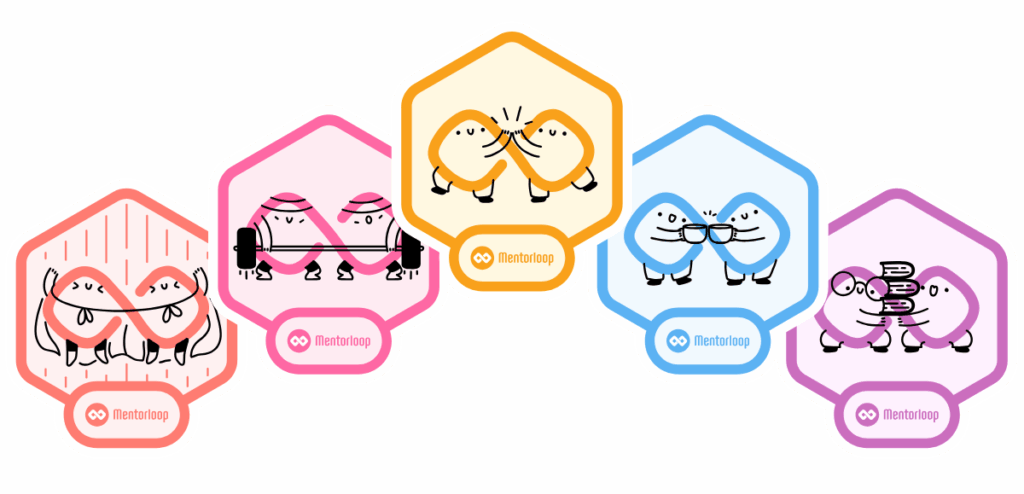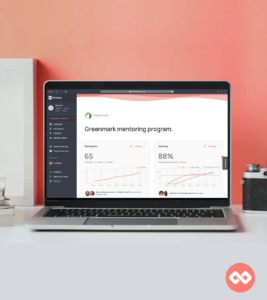As a Mentoring Program Coordinator, you invest a lot of time and effort in building your program. So it only follows that you don’t want all that to go to waste because of a lack of engagement within the program cohort. Increasing mentoring program engagement is something that we’re always asked about here at Mentorloop so we’re sharing what we’ve seen work in the hundreds of programs we’ve helped run.
Let’s get to it.

Gamification
Ah, good old gamification. As much as we all should have the self-discipline and internal locus of control to do what is best for us – we all sometimes find this tricky. We’re a little guilty of being terrible at doing what is best for us, particularly if there isn’t immediate gratification. Great mentoring takes time to develop, and the rewards are incremental. And that’s where gamification comes in.
Gamifying your mentoring program provides your participants with some immediate or short-term gratification to keep them motivated to reach the pot of gold at the end of their mentoring journey rainbow. Used correctly, gamification is an incredibly handy engagement tool.
Gamification opportunities are essentially endless. You can do things like creating incentives for engagement like giving away coffee or brunch coupons to mentoring pairs who have logged frequent meetings or entering those who respond to your requests for feedback into a raffle.
The important thing to remember is to make sure the rewards and rewarded actions align with your program goals and don’t take away from the mentoring relationships. The rewards should encourage engagement in such a way that your cohort can eventually see mentoring as the reward and no longer need the ‘carrots’ of gamification, and instead see these things as a nice bonus.
Kudos: Recognize and Reward Mentoring Efforts
Another exciting way to bring gamification into your mentoring program is with Mentorloop’s Kudos feature. Kudos lets participants easily acknowledge and celebrate each other’s contributions, whether it’s a mentor providing invaluable guidance, a mentee showing impressive growth, or even a peer supporting the cohort in meaningful ways.

Here’s why Kudos is such a powerful form of gamification:
- Instant recognition: Participants receive immediate positive reinforcement, which helps motivate continued engagement and effort.
- Peer-driven encouragement: Kudos leverages social recognition, making participants feel genuinely seen and appreciated by their peers.
- Aligned with program goals: You can encourage specific behaviors—like regular check-ins, goal achievement, or proactive support—by prompting participants to give Kudos for actions that support the mentoring journey.
- Builds a positive program culture: Seeing Kudos accumulate across the program fosters a sense of community, friendly competition, and collective achievement, all of which encourage ongoing participation.
Kudos transforms engagement from a task into a celebration of small wins. Participants feel motivated not just to “complete” mentoring activities, but to actively contribute to a supportive, thriving cohort. And the best part? It’s effortless for Program Coordinators! Kudos requires zero additional admin while keeping your cohort energized and engaged.
Leadership Buy-In
The easiest way to ensure employees get engaged with your mentoring program in the first place is to have leadership advocate for and back the program. Especially in workplace mentoring programs, people take their cues from leadership on how important an initiative is to them and their goals.
Having very senior-level leaders or even the CEO champion your program by speaking to how important this program is to them and how important mentoring has been to their own career is an effective way to get your participants interested and keep them engaged.
The best practice here is to have leadership support from the word “go.” Get your leaders’ support before you even formally launch the program to the wider organisation. Get them to send emails encouraging people to join, or even record a video.
See how one of 2023’s Most Impactful Programs, Ziff Davis did this:
Showcase the Benefits and Share Success Stories
We all rely on some form of proof of success in a lot of areas in our lives. Whether it’s making decisions about which supplier to go with for a big project or which restaurant to take a date to for dinner, we often look for something like portfolios or reviews. However, we sometimes forget to apply this in internal practices. It will be difficult to get people to get interested in and engage with a program if they don’t know or see its value.
Stories of success and the life-changing results that stem from mentoring relationships are your secret weapon here! Have your mentoring champions share their experiences with your participants.
Do you have a mentoring pair in your cohort from whom you’ve had particularly great feedback? Or participants from a previous cohort who have achieved cool things since as a direct result of the mentoring they’ve engaged in?
Whether you have them share their mentoring stories in writing or by speaking at a launch event, these stories are very effective at showing your cohort what’s possible if they invest in their mentoring relationships.
Try Self Matching
Humans are funny creatures. There are a number of psychological traits that we all exhibit and adhere to – and they are often centred around appearing consistent and avoiding cognitive dissonance. You can leverage this against your employees (in a good way!) by letting them choose their own mentor or mentee. For some people, commitment bias pushes them to stick to decisions they’ve made so choosing their own matches makes them more invested in the relationship with their mentoring partner.
If you run a Self Match program on Mentorloop, your participants are able to browse the cohort for mentors or mentees who they think will suit them based on their skills, goals, and even interests.
Support Participants with Content and Resources
Sending your cohort some helpful content and resources throughout the program not only keeps the program top of mind but also helps your participants navigate their mentoring journey better. Content on best practices for mentors and mentees or tips on how to structure their mentoring meetings are helpful, but obviously, the goals of your program will dictate what kind of resources will be appropriate.
Kickstart the program by sharing some resources that will help your mentors and mentees navigate the beginning of their mentoring relationships or help them be the best mentoring partner they can be. Share podcasts or blogs that can give your cohort some inspiration or useful tips. Do you have any in-house resources that you think might be useful for them? Remind your participants that they’re available!
When participants know that they are supported, it makes them more comfortable continuing with their mentoring journey. Sharing resources relevant to their journey is a great way to do this.
If you’re running your program on Mentorloop, the Recommended Reading lists are pre-populated with helpful guides and resources to help your mentors and mentees throughout their journey. You can also add to these lists and change them as you see fit.
Webinars
Webinars are also a great way to inject some engagement into your mentoring program. Schedule a 20-40 minute webinar with your participants to talk about topics like active listening, mentoring best practices, or Diversity & Inclusion issues. This is a great way to encourage your participants along on their mentoring journey or give them topics to discuss with their mentoring partners.
Open it up to questions and give participants a chance to engage with others in the program. It can help foster a feeling of community and encourage continued engagement.
Check-in With Your Participants
Sometimes, people just need a bit of a nudge. We’re all busy and sometimes new commitments or activities can get pushed to the side when we’re not used to making time for them.
Reaching out with a quick “How’s it going?” message can be just the reminder some participants need to get a move on.
Pro Tip: If you’re using Mentorloop, use your filters to find participants who haven’t sent match requests yet, or maybe haven’t had the first meeting with their mentoring partner yet. Send a bulk message to these participants asking if they’re having any trouble and if you can help in any way.
Mentorloop has a suite of momentum management tools designed to help program coordinators like you build and maintain good momentum in your whole cohort. Explore them here:
Let Participants Know They Can Reach Out
Lastly, make sure that your participants know that they can contact you if they have any questions or having any sort of trouble. Some participants might just need a bit of help to get going – and if they don’t know how to access support, it seems easier to just drop the whole thing.
Make sure they know that they can contact you and how they can do that. It can be as simple as a short check-in email every month or making support and contact information available and easy to find.
BONUS: Don’t forget the human aspect of mentoring!
At the heart of any mentoring program is the human connections that are made within them. In this age of measuring and analysing everything, this can sometimes get lost. Beyond the numbers and data that you collect about your mentoring program are the people who have made unlikely, life-changing connections and are moving towards their goals together.
Remember to celebrate these relationships and take some time to appreciate their stories together with your cohort. Sharing your program’s success, not just with your stakeholders but also with your cohort helps them feel like they’re part of something good and bigger than themselves. And when you do share your program’s success, remember to share stories alongside the data. The context behind the numbers is just as important.
On Mentorloop, we measure mentoring programs with Sentiment. This system makes sure that you’re getting balanced data – qualitative + quantitative. This ensures you get the full picture and can easily share it with your stakeholders and participants should you need to.
Watch this video to learn more about why we measure programs differently here at Mentorloop:
Keeping your program’s engagement healthy isn’t as difficult as you might think. These tips are great ways to increase your chances of getting a greater return on the time you invest in facilitating your mentoring program – and a great way to ensure your cohort stays engaged. We hope these help you keep your program buzzing with productivity and growth!
If you’re ready to engage your cohort in your best mentoring program yet, get started with Mentorloop Pro today!



